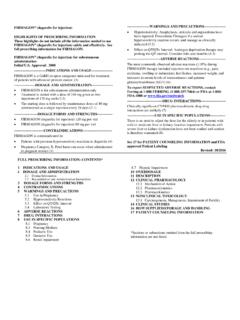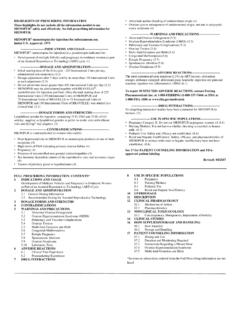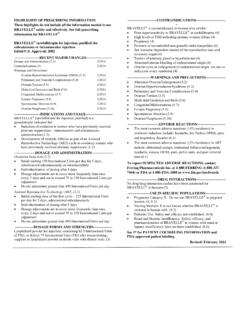Transcription of Euflexxa PI 6309501103 Rev. 07/2016 R4 1/27/2017
1 Euflexxa PI_6309501103_Rev. 07/2016_R4 1/27/2017 CONTENTEach 1 mL of Euflexxa contains: Sodium hyaluronate 10 mg Sodium chloride mg Disodium hydrogen phosphate dodecahydrate mg Sodium dihydrogen phosphate dihydrate mg Water for injection is a viscoelastic, sterile solution of highly purified, high molecular weight ( million daltons) hyaluronan (also known as sodium hyaluronate) in phosphate-buffered saline. Euflexxa is a very highly purified product extracted from bacterial cells. It is a polysaccharide consisting of repeating disaccharide of N-acetylglu cosamine and sodium glucuronate, linked by alternating b 1,3 and b 1,4 glycosidic (1% sodium hyaluronate) is indicated for the treatment of pain in osteoarthritis (OA) of the knee in patients who have failed to respond adequately to conservative non-pharmacologic therapy and simple analgesics ( , acetaminophen).
2 CONTRAINDICATIONS Do not use Euflexxa to treat patients who have a known hypersensitivity to hyaluronan preparations. Do not use Euflexxa to treat patients with knee joint infections, infections or skin disease in the area of the injection Mixing of quaternary ammonium salts such as benzalkonium chloride with hyaluronan solutions results in formation of a should not be administered through a needle previously used with medical solutions containing benzalkonium chloride. Do not use disinfectants for skin preparation that contain quaternary ammonium salts. Do not inject intravascularly because intravascular injection may cause systemic adverse Patients having repeated exposure to Euflexxa have the potential for an immune response; however, this has not been assessed in humans.
3 Safety and effectiveness of injection in conjunction with other intra-articular injectables, or into joints other than the knee has not been established. Remove any joint effusion before injecting. Transient pain or swelling of the injected joint may occur after intra-articular injection with Euflexxa . Do not use after expiration date. Protect from light. Do not re-use dispose of the syringe after use. Do not use if the blister package is opened or for Patients Provide patients with a copy of the Patient Information prior to use. Transient pain and/or swelling of the injected joint may occur after intra-articular injection of Euflexxa .
4 As with any invasive joint procedure, it is recommended that the patient avoid any strenuous activities or prolonged ( , more than 1 hour) weight-bearing activities such as jogging or tennis within 48 hours following intra-articular injection. The safety of repeated treatment cycles of Euflexxa has been established up to 1 in Specific Populations Pregnancy: The safety and effectiveness of Euflexxa have not been established in pregnant women. Nursing Mothers: It is not known if Euflexxa is excreted in human milk. The safety and effectiveness of Euflexxa have not been established in lactating women.
5 Children: The safety and effectiveness of Euflexxa have not been demonstrated in REACTIONSA dverse event information regarding the use of Euflexxa as a treatment for pain in OA of the knee was available from two sources; a 12 week multicenter clinical trial conducted in Germany, and a 26 week multicenter clinical trial conducted in the Device-Related Adverse EventsThe most common adverse events related to Euflexxa injections reported in the clinical studies are the following: Arthralgia Back pain Pain in extremity Musculoskeletal pain Joint swellingAll adverse events related to Euflexxa injections reported in Tables 1, 2.
6 3 and Adverse EventsThe following adverse events are among those that may occur in association with intra-articular injections Arthralgia Joint swelling Joint effusion Injection site pain Arthritis12 Week Multicenter Clinical StudyThis clinical investigation was a prospective randomized, double-blinded, active control (commercially available hyaluronan product) study conducted at 10 centers. Three hundred twenty-one patients were randomized into groups of equal size to receive either Euflexxa (n=160) or the active control (n=161).
7 A total of 119 patients reported 196 adverse events; this number represents 54 ( ) of the Euflexxa group and 65 ( ) of the active control group. There were no deaths reported during the study. Incidences of each event were similar for both groups, except for knee joint effusion, which was reported by 9 patients in the active control group and one patient in the Euflexxa treatment group. Fifty-two adverse events were considered device-related. Table 1 lists the adverse events reported during this 1. Incidence of Adverse Events Reported by >1% of PatientsBody SystemADEP atients, n (%) Euflexxa (n = 160)Active Control(n = 161)Gastrointestinal disorders Nausea 3 ( ) 0 General disorders and administration siteFatigue 2 ( )0 Infections and infestationsBronchitis1 ( )2 ( )Infection2 ( )0 InvestigationsBlood pressure increased6 ( )1 ( )Musculoskeletal, connective tissue and boneArthralgia14 ( )17 ( )Arthrosis2 ( )0 Back pain8 ( )11 ( )Joint disorder2 ( )2 ( )Joint effusion1 ( )13 ( )Joint swelling3 ( )3 ( )Pain in limb2 ( )0 Tendonitis3 ( )2 ( )Nervous system disordersHeadache1 ( )3 ( )Paresthesia2 ( )1 ( )
8 Respiratory, thoracic and mediastinalRhinitis5 ( )7 ( )Skin and subcutaneous tissue disordersErythema02 ( )Pruritus03 ( )Vascular disordersPhlebitis02 ( )A total of 160 patients received 478 injections of Euflexxa . There were 27 reported adverse events considered to be related to Euflexxa injections: arthralgia 11 ( ); back pain 1 ( ); blood pressure increase 3 ( ); joint effusion 1 ( ); joint swelling 3 ( ); nausea 1 ( ); paresthesia 2 ( ); feeling of sickness of injection 3 ( ); skin irritation 1 ( ); tenderness in study knee 1 ( ). Four adverse events were reported for the Euflexxa group that the relationship to treatment was considered to be unknown: fatigue 3 ( ); nausea 1 ( ).
9 Table 2. Relationship of Adverse Effects to Treatment Groups That Were Considered to Be Treatment Related Adverse Event( Euflexxa ) (Number of Reports)n = 160 Commercially Available Hyaluronan Product(Number of Reports)n = 161 Arthralgia119 Back pain10 Baker s cyst01 Blood pressure increase30 Erythema01 Inflammation localized01 Joint effusion 19 Joint swelling32 Nausea10 Edema lower limb01 Paresthesia20 Pruritus01 Sickness30 Skin irritation10 Tenderness10 TOTAL272526 Week Multicenter StudyThis was a multicenter, randomized, double-blind trial evaluating the efficacy and safety of Euflexxa , as compared with saline, in subjects with chronic osteoarthritis of the knee followed by an open labeled safety extension study.
10 The intervention consisted of three (3) weekly injections of study device into the target knee, with scheduled follow-up evaluations during the 26 weeks following the first injection. In the extension phase subjects received three (3) weekly injections of Euflexxa into the target knee with follow-up evaluation up to 52 weeks. Table 3 shows the treatment-emergent adverse events by preferred term with an incidence of 2% among treatment 3: Treatment-Emergent Adverse Events by Preferred Term with an Incidence of 2% among the Treatment Groups (Safety Population)System Organ Class Preferred Term26 Week FLEXX Study (Core)Extension Study Repeat Injection for 52 Weeks*All Treatments N = 588 n (%) SalineN = 295 n (%) Euflexxa N = 293 n (%) Euflexxa N = 219 n (%) Any TEAE326 ( )169 ( )157 ( )96 ( )Musculoskeletal and connective tissue disordersArthralgia62 ( ) 35 ( )27 ( )19 ( )Back pain23 ( )11 ( )12 ( ) 6 ( )Pain in extremity13 ( )10 ( )3 ( )3 ( )Musculoskeletal pain10 ( )4 ( ) 6 ( )2 ( )Osteoarthritis9 ( ) 7 ( )2 ( )0 Joint swelling8 ( )4 ( )4 ( )




